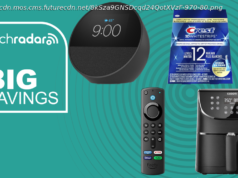Motorola’s Moto Z4 smartphone isn’t a massive upgrade from the Moto Z3, but it brings a few new nifty features to the table.
If you ask Motorola, people love Moto Mods — the doodads that magnetically affix to the back of handsets in the Moto Z lineup. In fact, the company claims the majority of its customers say they’d recommend handsets with Moto Mods, and it pegs the Z series’ satisfaction rate at over 80%. Perhaps it’s not surprising, then, that Lenovo-owned Motorola is doubling down on what’s working.
On the eve of the series’ fourth birthday and following a year that saw its mobile business achieve profitability four straight quarters in a row, Motorola is launching a new model — the Moto Z4 — with upgraded cameras, an edge-to-edge screen, and a battery that lasts up to two days on a charge. The Moto Z4 doesn’t exactly come as a surprise — leaks leading up to today’s announcement and a premature Amazon listing let the cat out of the bag. But it packs enough in the way of surprises to warrant a closer look.
The Moto Z4’s brushed metal body feels smooth and substantial in-hand, if not exceptionally ergonomic or palm-fitting. Motorola has the no-frills look down to a science, and this year’s iteration is machined from P2i splash-proof (but not waterproof) and nano-coated Series 6,000 polished aluminum with a flatter profile than rivals like the Google Pixel 3a and OnePlus 6T. That’s just fine in our book given the strictures at play; ditching the Z series’ aesthetic would’ve no doubt necessitated fragmenting the Moto Mods ecosystem, and it’s to Motorola’s credit that it put compatibility before style.
That’s all to say that the Moto Z4 won’t seem completely foreign to those who’ve owned or handled a Moto Z3. On the front, Gorilla Glass 3 shields the 6.39-inch display and its rounded corners, which measures a full 0.38 inches wider diagonally than the Z3’s screen and packs slightly more pixels at a Full HD+ 2,340 x 1,080 resolution (403 pixels per inch) compared with 2,160 x 1,080 (402 pixels per inch). The flavor’s OLED with a 19:9 aspect ratio and a so-called “micro-notch,” the latter of which gives the Moto Z4 an 85% screen-to-body ratio and bezel that’s slightly thicker than that of, say, the Pixel 3a. It’s particularly noticeable where the glass curves to meet the frame’s lip near the USB 3.1 (Type C) port, but considering that the Moto Z3 had even thicker bezels and a 77.6% screen-to-body ratio, it’s not a hard pill to swallow.
Speaking of the notch, it’s right beneath the earpiece and houses a 25-megapixel front-facing camera, and it’s flanked up top by a loudspeaker to the left and a SIM card slot to the right. Fans of the enduring 3.5mm headphone jack will be pleased to hear it’s present and accounted opposite these accouterments and adjacent to the USB-C port, on the bottom, where it sits inches from the proprietary 16-pin Moto Mods connector on the rear cover.
The back is mostly barren besides, save an embossed Motorola logo and a prominent round camera module jutting out from the top. There’s a 48-megapixel camera inside — quadruple the megapixel count of the Moto Z3’s rear sensor, for folks counting — accented by a fractal etching that glitters and gleams in the light, and accompanied by a laser autofocus sensor and a dual LED flash.
Worth noting is the optical fingerprint sensor embedded beneath the Moto Z4’s screen, which stands in for the Moto Z3’s side-mounted fingerprint scanner.
So what about the cameras? Well, the Moto Z4 takes a cue from Huawei’s Honor View20 with a 1.6um pixel size, 48-megapixel (f/1.7 aperture) sensor that’s the largest ever in a Z series phone. Why so large? Motorola’s using a pixel binning technique — Quad Pixel — that combines the electric charge from adjacent CMOS pixels to produce so-called “super-pixels,” which Motorola claims improves light sensitivity by a factor of four. The camera’s optically stabilized besides and boasts phase detection autofocus and laser autofocus, along with the aforementioned dual LED flash module to light up dim rooms and dark nights.






